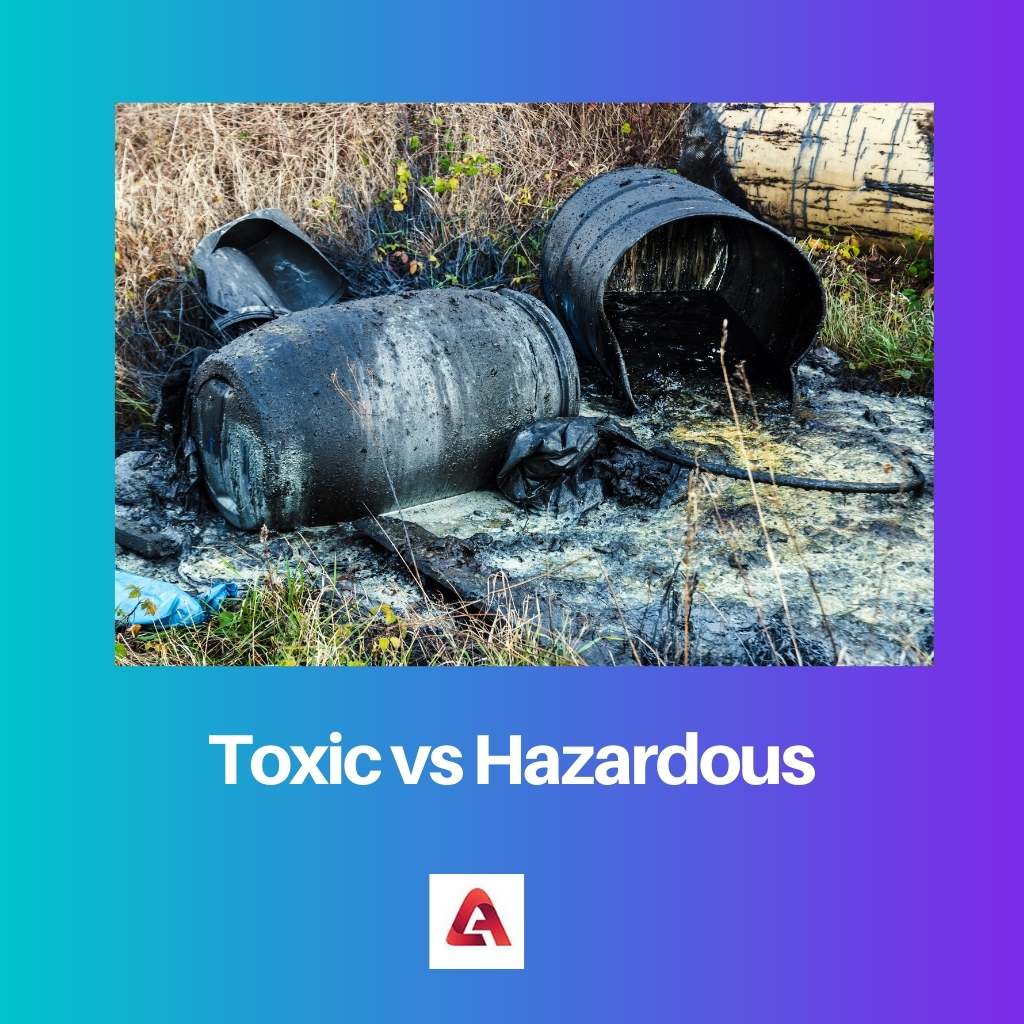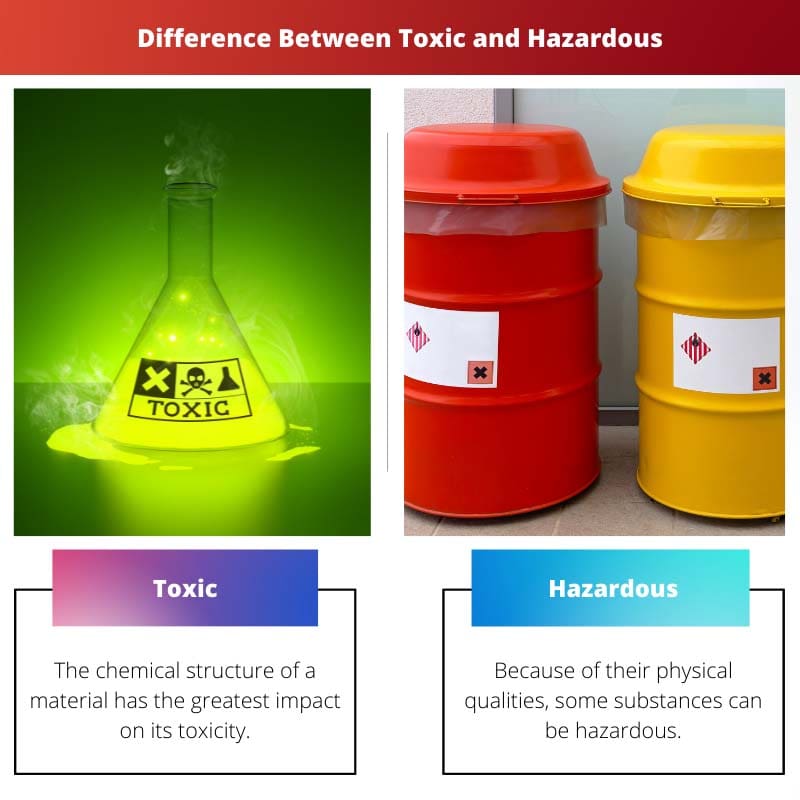Toxic means that a chemical substance has the power to cause harm if it reaches a vulnerable place in the body. Hazardous refers to the possibility that a substance will cause harm under particular circumstances.
The route of exposure, dose, medium, length of exposure, and potency all contribute to a substance’s toxicity.
Key Takeaways
- Toxic substances can cause harm to living organisms when ingested, inhaled, or absorbed; hazardous substances pose a risk to health, property, or the environment.
- Toxicity measures a substance’s potential to harm living organisms, while hazard considers the substance’s toxicity and the likelihood of exposure.
- Proper handling, storage, and disposal of toxic and hazardous materials are crucial to protecting human health and the environment.
Toxic vs Hazardous
Toxic refers to poisonous or harmful substances to living organisms, including humans. Toxic substances can cause various adverse health effects. Hazardous refers to substances that pose a risk of harm to people or the environment. Hazardous substances may be toxic, flammable, etc.

Toxicity is the ability of a chemical to cause harm to a living organism; harm can be caused by the chemical itself or by other substances formed when the original chemical is transformed within the organism;
Toxic is used as an adjective to show something malicious, harmful or hurtful.
The substance is said to be potentially hazardous if people are exposed to it in large enough amounts to cause harm.
A hazardous substance is said to be hazardous based on its physical properties, like being inflammable, toxic, reactive, or otherwise. Hazardous is the adjective form of hazard.
Comparison Table
| Parameters of comparison | Toxic | Hazardous |
|---|---|---|
| Factors affecting | The chemical structure of a material has the greatest impact on its toxicity. | Because of their physical qualities, some substances can be hazardous. |
| Usage in grammar | It can be used as an adjective to describe anything harsh or cruel. | Hazardous is an adjective that denotes posing a risk or posing a threat. |
| In medical context | It takes on the sense of displaying infectious signs. | Hazardous substances are those that are harmful to one’s health. |
| Includes | There is no such thing as non-toxic; anything, even water, may be harmful in excessive doses. | It contains explosives, diseases, cryogens, compressed gases, and other hazardous materials. Anything that has the potential to kill or injure someone is dangerous. |
| Determined by | Types of effect, potency, exposure, dose, medium, and length of exposure are all used to define a substance’s toxicity. | A chemical’s toxicity, method of exposure, duration, reactivity, and exposure are factors affecting hazardous nature. |
What is Toxic?
All chemical substances have toxicity as a feature.
It is a chemical’s relative ability to cause harm to a living organism, which can be produced by the chemical itself or by additional compounds generated when the original chemical is converted within the organism.
The term toxic can be used to describe something that includes or is made up of a harmful or poisonous chemical. Toxic substances can cause significant sickness.
For instance, the liquid in the container is toxic, so avoid touching it.
It takes on the connotation of presenting signs of infection or poisoning in a medical context. The noun form toxin, which refers to a dangerous or damaging chemical, especially one produced by a living creature, is connected to this.
Some trees, for example, are toxic because their leaves contain a potent toxin. In rare cases, the toxic can be used as a noun, although it is more employed as an adjective.
The potential for a material to cause harm is defined as its toxicity, and it is simply one aspect in deciding whether or not a hazard exists. The chemical structure of a substance is the most essential determinant of toxicity.

What is Hazardous?
When humans are exposed to the material in large enough proportions to cause damage, it is considered potentially hazardous. In a real-life situation, hazard lurks around every corner.
The hazard of a chemical is the practical likelihood that the chemical will cause harm. Hazardous is the broader way these include explosives, sharp and pointy things, pathogens, cryogens compressed gases.
Anything that can kill or hurt someone is hazardous.
Hazardous is the adjective form of the word hazard, which means a source of danger.
It can be dangerous in the sense of being toxic, such as hazardous materials, but dangerous as well as hazardous or less specific and doesn’t always cause harm,
whereas something that is hazardous, even death, would be such a loss it takes on the meaning of a chance of being unsafe.
For example, working in a coal mine can be hazardous. In this sense, it takes on the meaning of a chance of being unhealthy or unsafe.
The term hazardous does not have a figurative usage.
The following criteria determine whether a chemical is a hazard: toxicity, route of exposure, dosage, duration, reaction, and interaction.
What is the minimum amount of the hazardous drug necessary to cause harm, and how does the material enter your body?

Main Differences Between Toxic and Hazardous
- Toxicity or toxicity is a substance’s ability to cause harm, whereas A substance is potentially hazardous if people are exposed to it in large amounts to cause injury.
- The most significant element impacting a substance’s toxicity is its chemical structure, however, certain substances can be hazardous owing to their physical qualities.
- Toxic is used as an objective to show that something contains or is a poisonous substance, whereas hazardous is the adjective form of hazard which means a source of danger hazardous means involving risk or danger.
- The toxicity of a substance depends upon the route of exposure, dose, medium, and length of exposure, whereas a chemical is determined to be hazardous based on toxicity, route of exposure, dose, duration, reaction, and interaction.
- Toxicity is a subset of hazardous in that it causes biochemistry to go haywire in some manner if it gets to enter into one system, but hazardous encompasses a larger range of items such as explosives, sharp and pointed objects, infections, cryogen pressurized gases, and so on.

References
- https://books.google.com/books?hl=en&lr=&id=-z7aioZERTYC&oi=fnd&pg=PR5&dq=Difference+Between+Toxic+and+Hazardous+(With+Table)&ots=o4-ezUnUhZ&sig=ZeA_se1OYRkTVuEUJnphbQKWlJ0
- https://pubs.rsc.org/en/content/articlehtml/2017/sc/c7cs00885f

The medical context explanation of toxicity and hazardousness is enlightening. It provides a comprehensive understanding of these terms, which is essential for better handling and disposal of chemical substances.
The description is very helpful and resourceful. The potential harm from both toxic and hazardous materials is not to be overlooked. It is essential to be aware of how they can affect living organisms.
The article provides a wealth of valuable information on the distinction between toxic and hazardous materials. The comparison table is particularly informative and serves as a useful guide for evaluating the potential harm and risk factors associated with different substances.
I agree with you. It is indispensable for the protection of human health and the environment that proper caution is exercised in handling toxic and hazardous materials.
This comparison table can be a great reference to identify and understand the key differences between toxic and hazardous substances. The information is presented in a very clear and logical manner.
Yes, the medical context explanation is very illuminating, especially regarding the potential consequences of exposure to these substances. This is valuable information for both professionals and laypeople.
This is a crucial differentiation for toxic and hazardous materials. Understanding the contrast is vital for proper handling of materials.
This article effectively communicates the difference between toxic and hazardous, and provides a detailed comparison table for easy understanding. The accurate usage and description of these terms will undoubtedly lead to safer and more responsible handling of chemical substances.